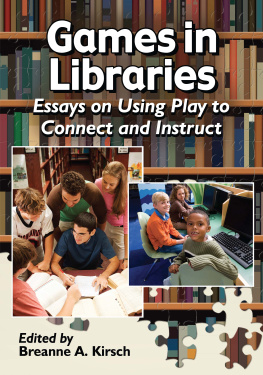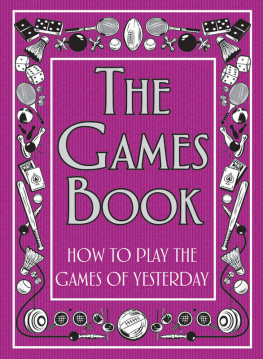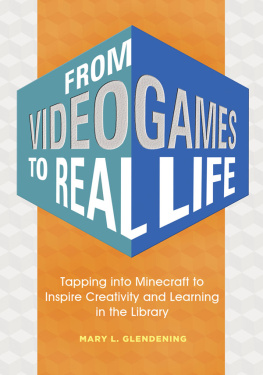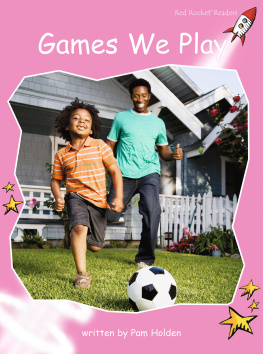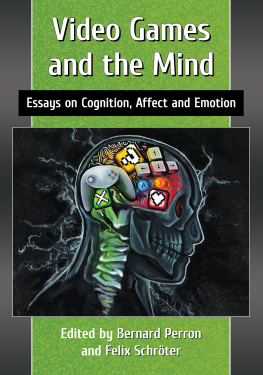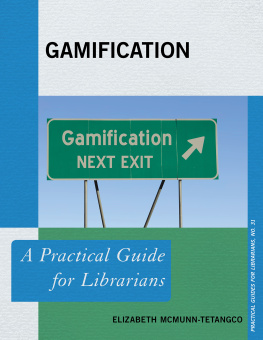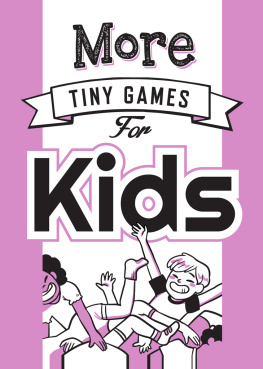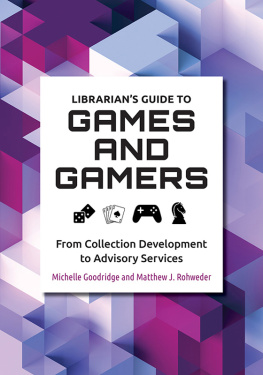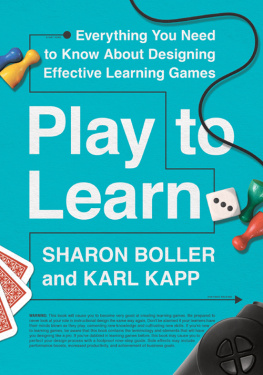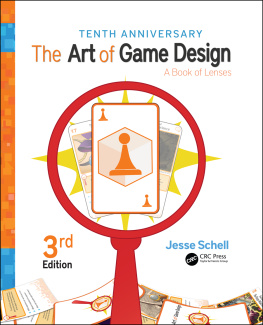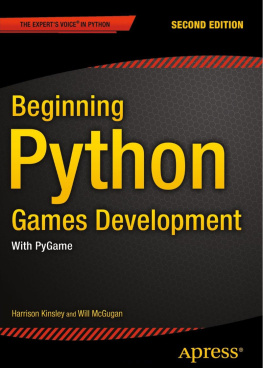
GAMES IN LIBRARIES
Essays on Using Play to Connect and Instruct
Edited by Breanne A. Kirsch

McFarland & Company, Inc., Publishers
Jefferson, North Carolina
LIBRARY OF CONGRESS CATALOGUING DATA ARE AVAILABLE
BRITISH LIBRARY CATALOGUING DATA ARE AVAILABLE
e-ISBN: 978-1-4766-1324-6
2014 Breanne A. Kirsch. All rights reserved
No part of this book may be reproduced or transmitted in any form or by any means, electronic or mechanical, including photocopying or recording, or by any information storage and retrieval system, without permission in writing from the publisher.
On the cover: group of students studying (Fuse/Thinkstock); children at computers (Purestock/Thinkstock); book background (Dimitry Merkushin/iStock/Thinkstock)
McFarland & Company, Inc., Publishers
Box 611, Jefferson, North Carolina 28640
www.mcfarlandpub.com
For Jon, Aleena, and Deb and Paul Geery.
I love you.
And for the librarians trying to stay innovative in a profession that is constantly changing with technology.
Acknowledgments
I would like to first thank my husband, Jon, who helped me solidify the idea for this book and get the courage to submit a book proposal to publishers. I would also like to thank my parents, Debra and Paul Geery; my sister, Aleena Geery; and my in-laws, Bob and Noel Kirsch.
Furthermore, I would like to thank all of the contributors who worked diligently on their essays as well as any revisions requested. Their hard work is what makes this an innovative collection of essays on making and using games in libraries. Finally, I would like to thank my co-workers and the dean of the University of South Carolina Upstate Library, Frieda Davison, who encouraged me to pursue this project.
Preface
Libraries are constantly evolving, and some things which were once viewed as fitting certain library types can be rediscovered or repurposed by different libraries. For example, popular fiction was and still is the focus of public libraries, but a number of academic libraries, including the University of South Carolina Upstate, have created leisure reading collections with popular fiction. Similarly, games are being used in a variety of ways in all library types. This book thus reflects a variety of library perspectives, as well as a genre fiction writers viewpoint. Just as the American Library Association strives to meet the needs of librarians from all types of libraries, these essays provide ways games can be used in different types of libraries with crossover applicable to all libraries.
This essay collection discusses innovative uses of games in libraries and focuses on the game making process. The contributors of this book are all interested in games and how they can be used for game-based learning or other library purposes, such as outreach. Each of the authors was selected by the editor because of conference presentations they have given on using games in unique ways at their institutions or because of expertise on a particular aspect of making or using games. The collection covers a wide variety of game usage across different types of libraries. While essays tend to focus on academic and public libraries, many of the ideas can be used in school and special libraries for similar reasons. The purpose of this book is to bring together distinctive uses of games in libraries or educational institutions and share these ideas with others to inspire the making and use of games by other librarians and educators.
The idea for this book came to me after attending a variety of conferences and hearing about exceptional ways games were being used in libraries and educational institutions. After listening to Andrew Battista at the past Georgia International Conference on Information Literacy in 2012 talk about how we could use badges to assess information literacy instruction, I thought this idea should be shared with other librarians and educators. The presentation motivated me to seek out other presenters and librarians for fresh, new ideas about making and using games in libraries and academic institutions. All of the authors of the essays within this book provide inspiring and informational examples of making and using games in libraries. I hope this book inspires you to think of new ways to make and use games at your library or institution.
Introduction
According to the Merriam-Websters Collegiate Dictionary, a game is an activity engaged in for diversion or amusement: play. When I think of games, I think of board games like Sorry or Monopoly or computer games I grew up with like Oregon Trails or SimCity. I also think of newer games, video games such as Wii Just Dance or Wii Super Mario. The immersive, popular online game World of Warcraft also comes to mind. Sports and so much else can also fall into the broad category of games. If we broaden it further, it can include things like gamification or using game-like elements for other purposes. Since so many different things can be aptly described as games, how can librarians play a role in this discussion and what types of games should we focus on?
As an academic librarian, I am particularly interested in game-based learning and how my students can learn information literacy skills through games. The New Media Consortium Horizon Project: 2013 Higher Education Edition lists game-based learning to be adopted within the next two to three years. Game-based learning is becoming more important to educators and as a result should also be important to librarians. This directly affects both school and academic librarians, with indirect applications for public libraries also.
The challenge mentioned in the Horizon Report for game-based learning is that educational games can be difficult to design well.
Games can be used in a variety of ways in educational situations. David Bailey, an instructor of English, has begun to use play-throughs to teach information literacy standards at Altamaha Technical College in Georgia. Play-throughs are simple video commentaries created by gamers to share gaming experiences and insights. This is a wonderful way that an English instructor is using game elements to teach students about the information literacy process.
In addition to game-based learning, there are many other areas within the broad topic of games that affect librarians. Some public libraries have been circulating video games for a number of years. A variety of libraries have begun using games or game-like events for outreach purposes, such as scavenger hunts or game nights. Incorporating games into library services can help increase patron engagement and interaction. This book discusses innovative and unique ways of using games in libraries.
The first essay, Levels of Game Creation by Cecilia Sirigos, discusses the characteristics of Generation Y (Millennials), how the popularity of gaming culture has influenced learning, and what librarians can borrow from video games and integrate into information literacy sessions to create an environment of engaged learning. Described in this essay are three stages of game incorporation: Newbie, Seasoned Player, and Level Five Sorceress. Each level offers suggestions on ways to combine game characteristics into instruction sessions and examples from academic institutions currently employing such tactics. Finally a short resource list is included for librarians interested in creating games in their own information literacy sessions.
Next page
